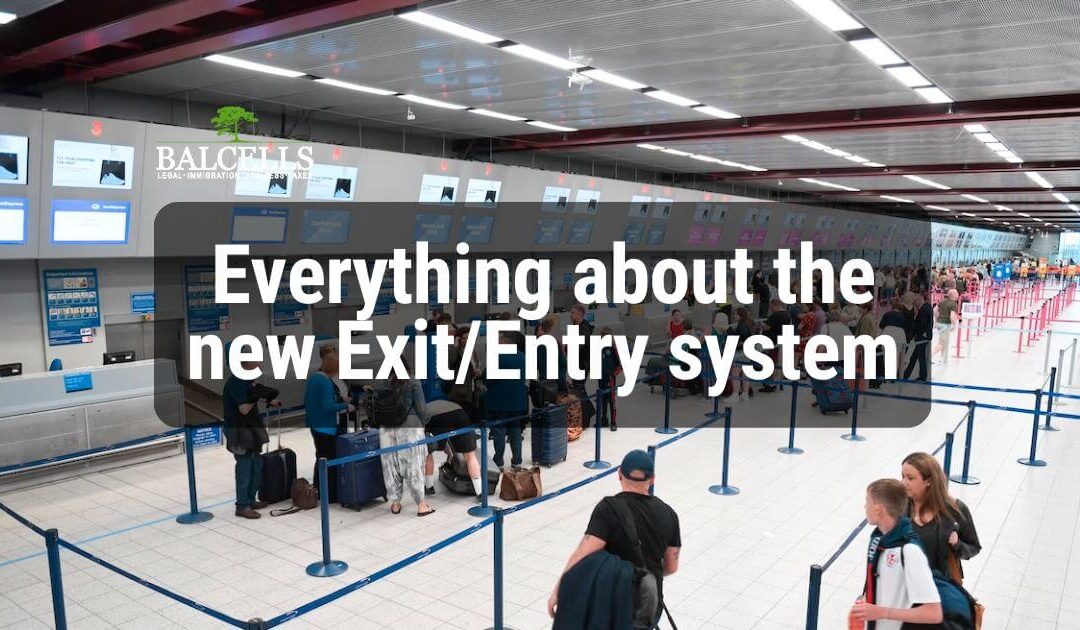More and more countries are being equipped with it. The new Exit/Entry system in Europe is about to be fully launched and revolutionize how travelers cross the Schengen Area borders. Entering Spain, Italy, France or any other of the member’s countries will from now on be completely different, and fully understanding how is essential.
That is why in this article you are about to learn everything you need to know about this new system, including exactly how it works, how it will affect immigration, and all changes you will experience as a traveler when visiting any EU country.
What is the entry-exit system or EES?
The European Entry Exit System (or EES) is the new process by which third-country travelers crossing EU external borders will have to go through in the near future.
But what does that exactly mean?
Basically, it means that all countries part of the Schengen Area will equip their border crossing points with a system looking like a self-service kiosk (or any other related border control unit) that will check all the required data from the traveler and digitalize it.
And when we say border we are talking about air, sea, and land.
And who exactly will be affected by this system?
All non-EU citizens (including those who must apply for a short-stay visa but also those who don’t thanks to an agreement), will have to be registered through this system at entry.
The are several advantages of the European Entry-Exit System, and its aim is twofold.
On the one hand, it was created to protect and strengthen the European or Schengen borders (preventing irregular migration as we will see in the next section, and by detecting fake IDs and passports).
And, on the other, it speeds up border crossing and reduces queuing time, allowing identified travelers to enter the country faster while having border officials just spend time on those who require it.
Among all, maybe one of the most important novelties this measure brings along is that it will completely eliminate the physical stamp on your passport when traveling.
Make sure to read until the end to fully understand the important consequences of this.
How does the EES work?
Up till now, when checking a specific traveler entering the Schengen Area, we had the data and documents from one side, and then an officer manually checking that the physical person that arrived at the airport matches with that data and documents.
With an Entry/Exit System, technology replaces that border official and validates that match between traveler and documents/data faster and easier for all parties involved.
To exemplify the increased efficiency of this measure, the US has been able to reduce up to 400% of the time that it took an official border to register biometric data (fingerprints + photo of traveler), by installing self-service kiosks in which the traveler took this data by herself.
Moving on to the intricacies of its operations, there are two main blocks behind the whole system:
- At the European level, a shared biometric matching system (acting as a big database that all countries can access)
- At the national level, an entry and exit system used by each country
All this data registered by each country will be sent to a general database controlled by the IT European Agency called eu-LISA, who also supports the complete technological infrastructure.
If you want more information, you can also check the different sections on the official site of the EES here.
What differences will you experience as a traveler?
The experience of entering a new country will be radically different once the EES is finally deployed.
Depending on how large the border crossing is, this experience may change:
- For example, in small border crossings, travelers will just as before go to the counter to get their fingerprints taken, face scanned and documents scanned
- But on the other hand, larger points like big airports could incorporate kiosks where the traveler can self-register
But, again, is important to note that this may also differ according to the state and border crossing, in some finding other portable solutions like a tablet.
If you face the most likely scenario, which is entering the country through an airport, you will be facing one of these high-technology kiosks. And there three different things will happen:
- Your face will be scanned
- Your passport will be also scanned, capturing data such as your name or date of birth
- This kiosk will also register the biometrics from 4 fingers of your right hand
Besides, the date and place of entry and exit will be registered, this being one of the most crucial impacts of this new measure.
Also, and as we have said, once this system is fully implemented passport stamps will no longer be used to identify when a foreigner entered a country for the first time.
How is that possible?
Basically, the passport stamp will be replaced by a digital stamp that will directly flow into the IT systems of the different border crossings.
When will this system be finally implemented?
Many Schengen Area countries have been already implementing these self-kiosks at their border crossings, and more will continue to do so in the upcoming months.
Spain, for example, is planning to deploy its Exit/Entry system during 2025; planning to install over 1.500 border control inspection units across the country.
The exact or final date when all countries will have this system in place is yet to be defined and is still uncertain, but everything points to 2025.
By now, just Lithuania has announced a complete and final installation of all systems, being the only country 100% ready.
The impact of the Exit/Entry system on immigration
What we have explored so far is simply related to your “traveler experience” when arriving in a new country and crossing its borders.
But we haven’t yet mentioned the HUGE impact this new digital system will imply when it comes to immigration in Europe and more precisely to any of the Schengen Area countries.
As you may know, if you overstay your tourist visa days and spend more than 90 days in any of the Schengen countries without obtaining a residency permit, you won’t be able to enter back again as there would be a risk of another overstay.
But many foreigners went over that fact by renewing their passports, hence eliminating the physical stamp that showed when they entered the country and hence being the proof of their overstaying.
But that won’t be possible anymore.
As the Entry/Exit system will generate a digital stamp (so your physical passport would be kept intact) all records of entry/exit will be stored on the online European databases.
Hence, all foreigners will have to fully comply with the 90-day rule, and no exemptions will be possible.
But not only that.
The EES will also record refusals of entry, which will be stored with the traveler’s profile and considered in future attempts to cross the borders of any of the member countries.
What is the difference between ETIAS and EES?
With both new measures being applied during similar types, many foreigners have doubts about the differences between both.
And the truth is that they are completely different things.
As we explored in this article, the ETIAS is travel authorization that non-EU citizens who DON’T need a visa to enter the Schengen Area will have to obtain, in order for the EU to gain better control of those access.
But the ETIAS is not a visa, and it is not an IT system like the EES.
Hence, the Entry/Exit system, on the other hand, is the border crossing system or technology that will be implemented so that travelers can self-check and will validate all their data.
So, as you can see, the ETIAS is a travel authorization that will be checked in any of the EES self-check kiosks.
Of course, both are new measures implemented by the EU in an effort to generate more solid immigration policies and have more efficient and profound control at its borders.
While it is true that many countries have started installing both, we are yet to see how the new EES finally evolves and becomes a reality.
And remember, if you need personalized immigration assistance to move to Spain, get in touch with our immigration lawyers today and enjoy a successful process:
Book a consultation with one of our lawyers and solve all your doubts

At Balcells Group we have been foreigners effortlessly moving to Spain for over 11 years. We help expats from all around the world with their immigration, business, tax and legal needs; ensuring a legally safe and enjoyable transition to the Spanish territory. Our multilingual team understands the importance of adapting to the cultural and legal specificities of our international clients. We offer a comprehensive service that combines the expertise of several generations of lawyers with the innovation needed to address today’s legal challenges, always striving to simplify processes and ensure reliable, effective results.




